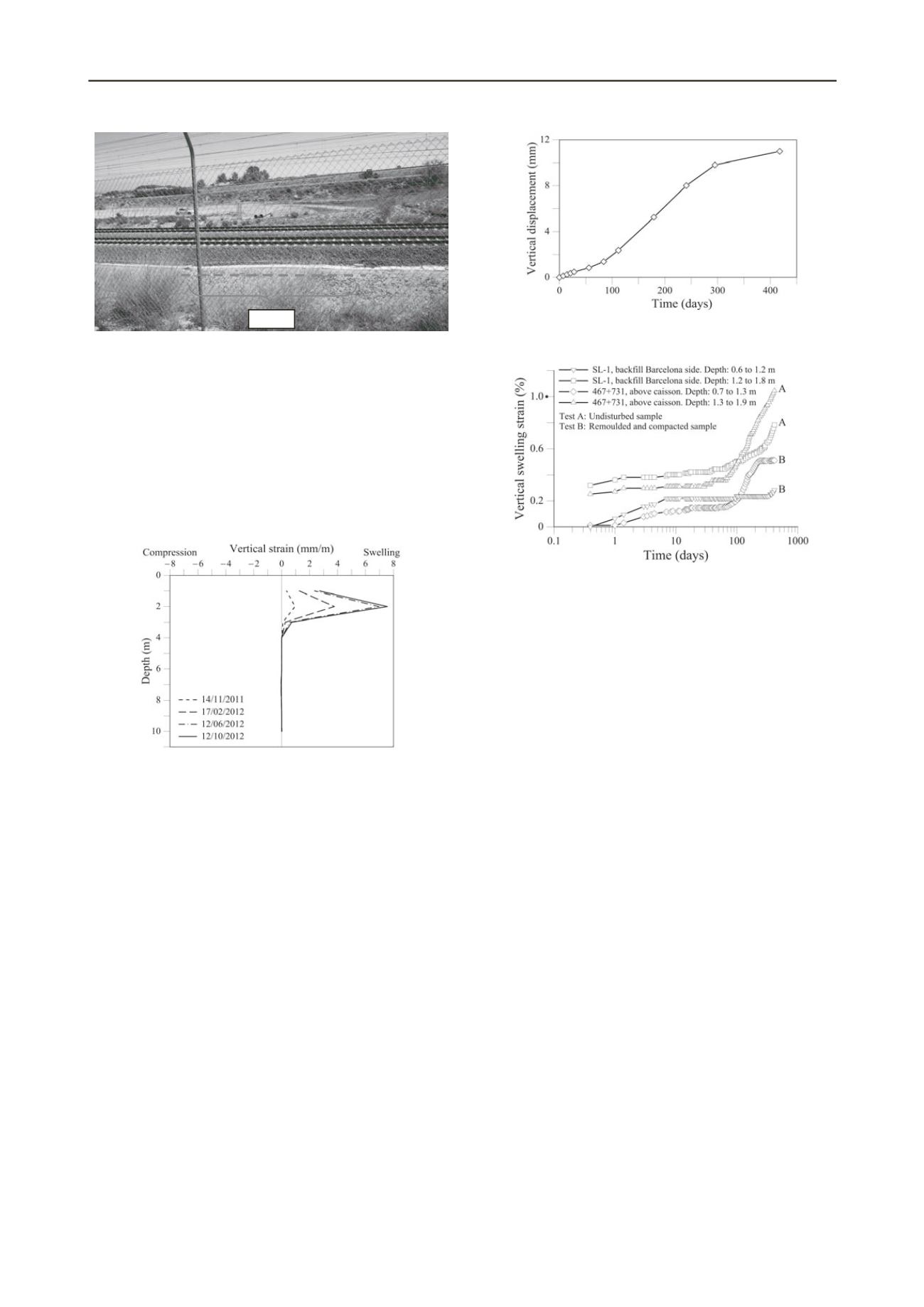
787
Technical Committee 103 /
Comité technique 103
Figure 5. Bulge of the surface above the caisson. Observe the reduced
thickness of the ballast layer
3.3
Laboratory tests
A mineralogical analysis by means of X-ray diffraction on
samples recovered from the upper meters of boreholes revealed
the presence of ettringite and gypsum in the material recovered
from the treated (classified as low plasticity clay and sand
mixtures).Calcite, quartz, dolomite and illite were also found.
The presence of wet material can be probably related with the
ettringite crystal growth because the crystalline structure of
ettringite crystals content a high percentage of water.
Figure 6. Vertical strains measured in depth along the continuous
extensometer SL-1 installed within the backfill of the concrete caisson
Identification tests were performed on samples recovered
from boreholes drilled at the backfills and above the caisson.
Sulphate and soluble salts content tests were also conducted on
some of the recovered samples. The soluble sulphate content
obtained in all samples is lower than 1%. The water contents in
the samples tested from boreholes SL-1 and SL-2 are
respectively 8.4% and 11%. A maximum value of water content
of 16.1% was measured in the laboratory in a sample recovered
from the layer placed above the caisson. The values of dry
density and water content in the tested samples indicate that the
materials located in the upper layers in the vicinity of the
caisson not only have increased in humidity but they had also
lost density. The increase in humidity and the decrease in
density are related to the crystal growth associated with the
sulphate attack to cement.
Free swelling tests were performed on samples prepared with
the material recovered in boreholes. Undisturbed samples as
well as samples compacted at the dry density corresponding to
the Normal Proctor test were tested. All samples were partially
submerged in water and were placed inside a cold-storage
chamber at a constant temperature of 8ºC during the test to
reproduce favourable conditions for ettringite and thaumasite
growth. Two types of samples were tested with material from
each location. Figure 8 shows the vertical swelling strains
measured during the free swelling tests performed. Swelling
evolves in time in all the samples tested without signs of
levelling off.
Figure 7. Accumulated vertical displacements measured by a continuous
extensometer
Heave
Figure 8. Swelling vertical strains recorded in free swelling tests
4 CHEMICAL MODELLING
With the purpose of getting an improved understanding of the
sulphate attack, a simulation of the processes taking place at the
soil-cement interface was performed with the help of a general
purpose transport and chemical reactions program (RETRASO:
Reactive Transport of Solutes: Saaltink et al., 2005). RETRASO
solves the coupled hydraulic transport processes and the
chemical reactions. The code handles mineral precipitation and
dissolution reaction under a large set of experimental kinetic
and equilibrium laws.
A simple 1-D problem, illustrated in Figure 9a, was
analyzed. Two porous materials, the compacted soil and a
cement grout, interact through a common interface. Only diffuse
processes are considered. There was an interest in knowing the
evolution and distribution of constituents in space (on both sides
of the interface) and time, and the pH of the medium, a key
piece of information to explain the sulphate attack. This
geometry is especially relevant for the attack of jet grouting
columns in Pallaressos embankments.
Initial equilibrium values, pH = 7.7 and pH = 12.4, were
calculated for aqueous solutions in equilibrium with soil and
cement, respectively. Then, RETRASO was used to obtain the
precipitated or dissolved amounts of calcite, dolomite, gypsum,
ettringite, kaolinite, quartz and portlandite (calcium hydroxide).
Some results are given in Figure 9 for a calculation period of
five years.
The pH maintains a high value on the cement side of the
interface. A plume of high pH values migrates progressively
towards the soil (Fig. 9b). In parallel, an ettringite front
advances (Fig. 9c) in the cement medium. In 5 years, a deep
penetration is calculated (
1.5 m). The sulphate attack started
(against the treated wedge and, later, against jet grouting
columns) in 2006 soon after the end of the embankment
construction. The calculated depth of the ettringite front in
Figure 9c suggests that the attack has currently (2012) affected
the whole volume of the grouted columns. In fact, in all samples
from embankments recovered at different positions, ettringite
and/or thaumasite was identified. Kaolinite is being
progressively dissolved in the soil, starting at the interface.


